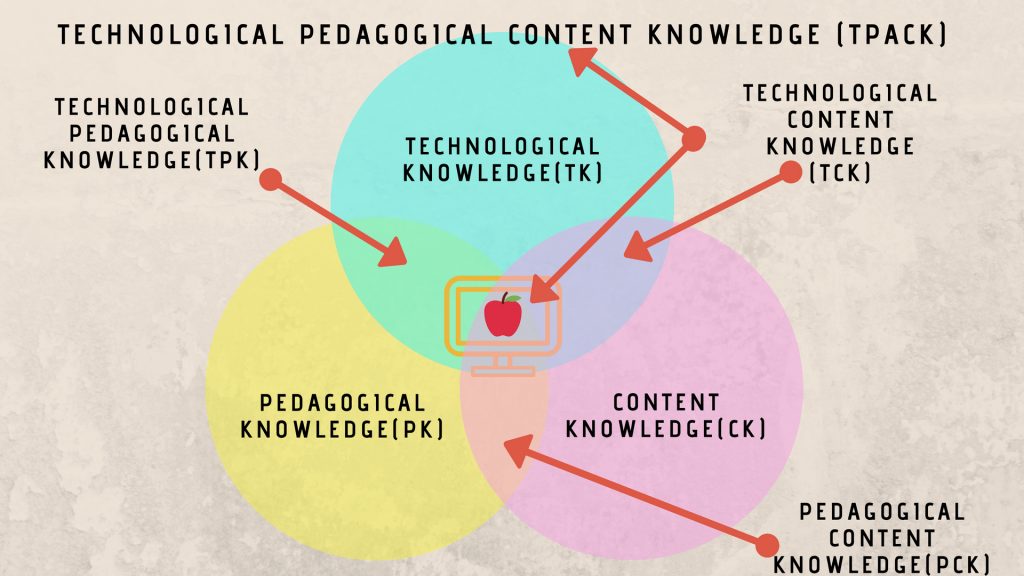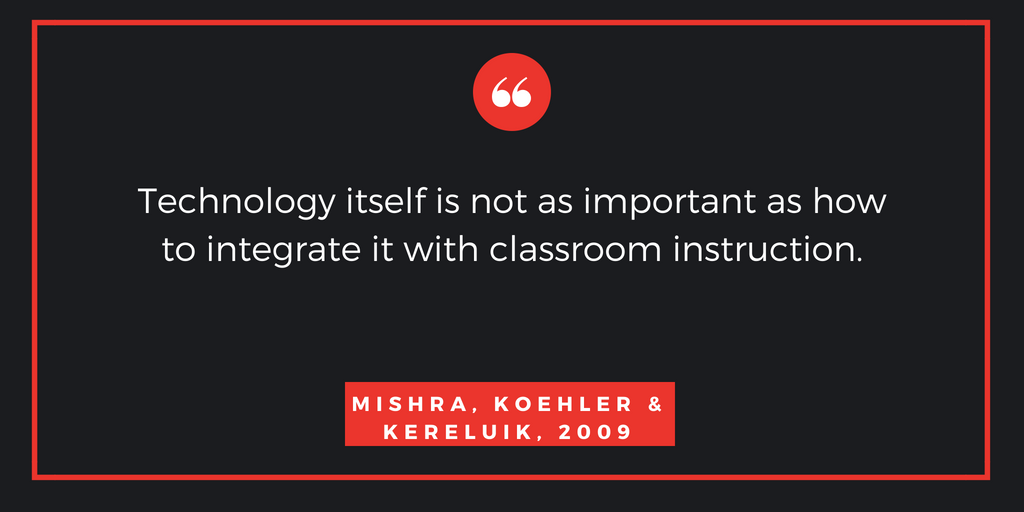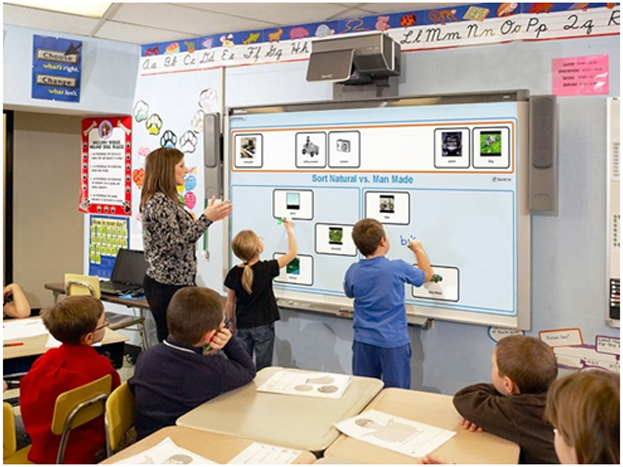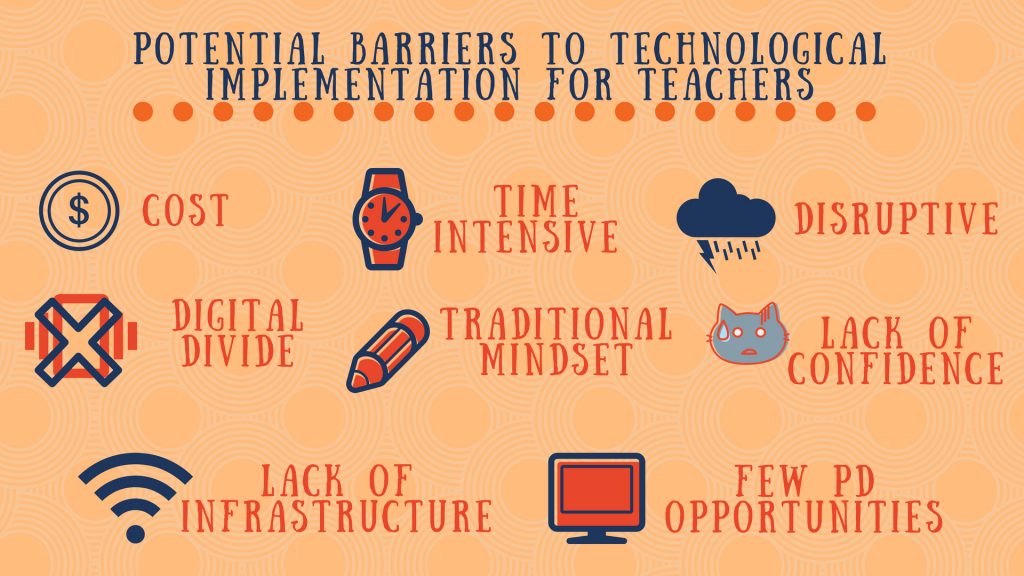Technology Integration Models and Barriers
9
Lisa Dietrich
Lisa Dietrich (lisa.dietrich@uoit.net)
University of Ontario Institute of Technology
Abstract
TPACK refers to the knowledge and competencies at work within the complex profession of teaching, examined through the lens of the Technological, Pedagogical and Content Knowledge infrastructure. Closely aligned with the interdependent relationships between these competencies exists the implications of those conditions created once technology is figured into the equation. Mishra and Koehler posit that the competencies inherent in the three core knowledge areas, must work in tandem with pedagogical content knowledge, technological content knowledge and technological pedagogical content knowledge for the essence of TPACK to be fully realized. Essentially, fluency within and between these core domains is required for successful adoption of technology within the curriculum.
Keywords: curriculum, pedagogy, teaching, technology, TPACK.
Introduction
The concept of Pedagogical Content Knowledge (PCK) was first introduced by Lee Shulman in 1986, and later revisited by Punya Mishra and Matthew Koehler in 2006. Over the past 20 years, the progression of technology and the flexibility it offers educators to enhance and promote learning, prompted Mishra and Koehler to incorporate a technological domain, to speak to those emerging affordances. Education has gone through a transformation with technology at the helm, reconfiguring the pedagogical landscape and opening doors for more robust teaching and learning opportunities for both educators and students. In many classrooms, the presence of technological tools is interwoven into the fabric of many teaching pedagogies such as those involving mobile applications. The restructured TPACK model encapsulates Shulman’s three original domains and their interrelationships within the educational context. Mishra and Koehler’s reimagined framework goes further to detail the complex interplay between Technological, Pedagogical and Content Knowledge once a teacher has elected to integrate technology within the curriculum, unveiling the intrinsic role that technology now assumes within the classroom environment.
What is the TPACK Model?
Punya Mishra and Matthew Koehler, developers of the TPACK framework, contend that uniting technology within the classroom has further complicated the teaching profession. They propose that understanding how these bodies of knowledge, both theoretically and in practice interact, will provide teachers with the types of flexible knowledge needed to successfully integrate technology use into their teaching practice (Koehler & Mishra, 2009).
Utilizing Shulman’s Pedagogical Content Knowledge (PCK) framework to form the basis for their model, Mishra and Koehler identified three core components at the heart of good teaching practices: Content, Pedagogy, Technology and the interrelationship among and between them. The domains are represented as PCK (Program Content Knowledge), TCK (Technological Content Knowledge), and TPK (Technological Pedagogical Knowledge or TPACK) as illustrated in Figure 1:

Background Information
Lee Shulman
Lee Shulman, professor emeritus at Stanford Graduate School of Education, has focused on two key themes through much of his research as an educational psychologist:
- Cognition in professional practice, particularly under conditions of uncertainty and
- The domain-specificity of expertise (Shulman, n.d.)
Shulman first coined the term Pedagogical Content Knowledge (PCK) through his research involving new teachers and the process of assimilating content knowledge. The research posed many questions, among them, the following:
- Where do teacher explanations come from?
- How do teachers decide what to teach, how to represent it, how to question students about it?
- How do teachers take a piece of text and transform their understanding of it into instruction that their students can comprehend? (Shulman, 1986, p. 8).
Shulman’s research was positioned to address such pedagogical perplexities surrounding the ways in which teachers, novice or seasoned, draw on expertise in the subject matter in the process of teaching (Shulman, 1986). Essentially, understanding how one determines what and how to teach for optimum, authentic learning to occur is valuable information for educators since it speaks to how learning for teaching occurs and this insight, can clarify the strengths and weaknesses of strategies currently being utilized.
Soon after embarking on his journey to uncover the intricacies of teacher understanding and transmission of content knowledge, Shulman realized that a more detailed theoretical framework from which to isolate his findings was required, in efforts to move forward in his research and thus, the PCK model was born (Shulman, 1986).
Three Categories of Content Knowledge
Shulman commenced this process by defining three categories of Content Knowledge, namely: Subject Matter Content Knowledge, Pedagogical Content Knowledge and Curricular Knowledge.

1. Subject Matter Content Knowledge
- Subject Matter Content Knowledge or simply, Content Knowledge, (CK), is the amount and organization of knowledge in the mind of the teacher
- To think properly about content knowledge requires going beyond knowledge of the facts or concepts of a domain to understanding the structures, such as those outlined in Bloom’s Taxonomy of Cognitive Learning Objectives (Adams, 2015)
- The teacher needs to go beyond basic knowledge of a subject to the why, with proof and, under what circumstances our belief in its justification can be weakened or refuted (Shulman, 1986)
- We also expect the teacher to understand why a given topic is particularly central to a discipline in contrast to others that do not assume center stage (Shulman, 1986., p. 9)
2. Pedagogical Content Knowledge
- Pedagogical Content Knowledge or PCK, refers to the subject matter knowledge for teaching or, the representation of those ideas, the most powerful analogies, examples, explanations, and demonstrations of that knowledge that present as clear, comprehensible illustrations
- An understanding of what makes the learning of specific topics easy or difficult alongside the preconceived notions of what students from various backgrounds and ages bring with them to the learning environment, is intrinsic to PCK (Shulman, 1986)
3. Curricular Knowledge
- Curricular Knowledge or CK, constitutes the full range of programs behind the subject being taught, coupled with the instructional materials such as texts, software, programs and visual materials at the disposal of the teacher
- CK refers to the justification of those selected instructional materials and speaks to the necessity for teachers to demonstrate the ability to relate the content of a given course or lesson to topics or issues being discussed across other subject areas (Shulman, 1986)
21st Century TPACK: Enter Punya Mishra and Matthew Koehler
Punya Mishra, Associate Dean of Scholarship & Innovation at Mary Lou Fulton Teacher’s College, Arizona State University and Mathew Koehler, Professor, Department of Counseling, Educational Psychology and Special Education at Michigan State University, reimagined the model from the perspective of 21st century skill building, closely integrating the presence of technology into Shulman’s framework.
Through intensive examination of Shulman’s work, colleagues Mishra and Koehler became invested in the study of the interrelationships between the Content, Pedagogical and Curricular domains developed by Shulman. Specifically, their research of these domains exposed an omission in lieu of the growth of technology within education since Shulman’s seminal work had been completed, prompting them to modify the existing PCK model to include that of educational technology. (Koehler & Mishra, 2009).
Through the inclusion of the technical content knowledge required to engage students through the utilization of an expanded array of technological tools, the Technological Content Knowledge Domain (TCK) aptly captures the intrinsic nature of technology’s potential presence in today’s educational environment. Mobile devices and tablets, the collaborative landscape of web 2.0 that provide for innovative pedagogies that extend beyond the concrete walls of the classroom to the virtual, are captured and interwoven into the TPACK model.

The Core Components of TPACK
Content Knowledge
Content knowledge (CK) is the teachers’ knowledge about the subject matter to be learned or taught. This knowledge includes knowledge of concepts, theories, ideas, organizational frameworks, knowledge of evidence and proof, as well as established practices and approaches toward developing such knowledge (Mishra & Koehler, 2009).
Key points
- In the case of art appreciation, such information would include knowledge of art history, famous paintings, sculptures, artists and their historical contexts, as well as knowledge of aesthetic and psychological theories for evaluating art
- The cost of not having a comprehensive base of content knowledge could include students receiving incorrect information and developing misconceptions about the content
Pedagogical Knowledge
Mishra and Koehler, 2009, speak to Pedagogical knowledge (PK) as teachers’ deep knowledge about the processes and practices or methods of teaching and learning. They encompass, among other things, overall educational purposes, values, and aims. Pedagogical knowledge requires an understanding of cognitive, social, and developmental theories of learning and how they apply to students in the classroom.
Key points
- General classroom management and lesson-planning are overarching themes in this domain
- Providing encouraging feedback via assessment creates a positive space for learning
Technological Knowledge
Technology Knowledge (TK) is always in a state of flux. Mishra and Koehler (2009), embrace Fluency of Information Technology or FITness, to describe the TK component; the framework was originally proposed by the Committee of Information Technology Literacy of the National Research Council NRC (1999). FITness guidelines extend beyond traditional notions of computer literacy to require that persons understand information technology broadly enough to apply it productively at work, and in their everyday lives, understanding the need for flexibility as technology advances.
Key Points
- A deep understanding of information technology for information processing, communication and problem-solving is required
- This level of understanding is necessary to afford individuals the ability to utilize technology to accomplish a variety of different tasks and to develop different ways of accomplishing those tasks
The Domains
Pedagogical Content Knowledge
Mishra & Koehler, 2009 state that Pedagogical Content Knowledge (PCK) covers the core business of teaching, learning, curriculum, assessment and reporting. An awareness of common misconceptions and ways of looking at them, the importance of forging connections among different content-based ideas, students’ prior knowledge, alternative teaching strategies, and the flexibility that comes from exploring alternative ways of looking at the same idea or problem are all essential for effective teaching.
Key Points
- The essence of PCK is found in how teachers interpret and choose to represent the subject being taught by ways of methodologies and technologies selected
- The conditions that promote learning and the links among curriculum, assessment, and pedagogy embody the PCK domain
- PCK speaks to the necessity for teachers to examine the learning environment from multiple angles and assess various methods of teaching for effective selection of delivery methods
- Re-evaluating curriculum with a view to students’ prior knowledge is recommended
- Exploring different teaching strategies is central to this domain, in efforts for teachers to connect different content-based ideas
Technological Content Knowledge
Technological Content Knowledge (TCK) is an understanding of how technology and content influence and constrain one another (Mishra & Koehler, 2009).
Key Points
- Teachers need to understand what specific technologies are best suited for addressing subject-matter learning in their domains and how the content dictates or perhaps even changes the technology—or vice versa
- Viewing the heart as a pump (Trinity Animation, 2018) is a way in which technology has provided new perspectives for understanding phenomenon
Technological Pedagogical Knowledge
Technological Pedagogical Knowledge (TPK) is an understanding of how teaching and learning can change when selected technologies are used in specific ways. This includes knowing the pedagogical affordances and limitations of a range of technological tools as they relate to disciplinarily and developmentally appropriate pedagogical designs and strategies (Mishra & Koehler, 2009).
Key Points
- To build TPK, a comprehensive understanding of technological tools and how they can be pedagogically integrated for enhancement of learning is imperative
- Since most software programs are not designed for educational purposes, teachers need to develop skills to look beyond most common uses for the technologies, reconfiguring them for customized pedagogical purposes

Technology, Pedagogy and Content Knowledge
Technology, Pedagogy and Content Knowledge (TPACK) goes beyond all three core components of content, pedagogy, and technology and forms the basis for effective teaching with technology (Mishra & Koehler, 2009).
The following conditions exist within Technology, Pedagogy and Content Knowledge:
- The representation of concepts using technologies
- Pedagogical techniques that use technologies in constructive ways to teach content
- Knowledge of what makes concepts difficult or easy to learn
- An understanding of how technology can help redress some of the problems that students face
- Knowledge of how technologies can be used to build on existing knowledge
Teachers need to develop fluency and cognitive flexibility not just in each of the core competencies (Technology, Pedagogy and Content), but also in the interplay that exists between these domains and contextual parameters, so that they can construct effective solutions (Mishra & Koehler, 2009).
The TPACK model incites teachers, researchers, and teacher educators to move beyond oversimplified approaches that treat technology as an afterthought, redirecting their attention to the ways in which the connections among technology, content, and pedagogy, unravel within the classroom setting (Mishra & Koehler, 2009).
Addressing the Challenges of Technology
Each new day brings rapid, technological progress and while we are living in a time that is rife with the technological implications for education, it can also be overwhelming to teachers. New teachers or, teachers who have an established teaching style and are comfortable with traditional approaches to classroom learning, are often those who experience the greatest challenges. Some of the predominant barriers that teachers face with respect to the integration of technology into the classroom are captured in the infographic below:

TPACK classifies the types of knowledge into manageable pieces and expresses the relationship between each distinguishing component, allowing teachers to address some of the above concerns such as lack of confidence. TPACK can serve as a guiding template for efforts surrounding technology integration. Teachers are prompted to revisit existing teaching strategies and contemplate ways they can attain the deeper understanding required to satisfy the expectations contained in the dynamic nature of the intersecting domains. The TPACK method embodies a holistic approach to successful teaching.
Applications
Mishra, Koehler & Kereluik (2009) assert that technology itself is not as important as how to integrate it with classroom instruction (Incikabi & Tokmak, 2013, p. 293). Preparing teachers through the integration of TPACK into training for technology integration, will provide more perspective regarding the multi-faceted nature of technology, content and pedagogy.
Using TPACK to Assist Mathematics Teachers Effectively Integrate Technology for Instruction
The following example positions the TPACK model as the basis for framing instructional practices within an educational environment.
The National Council of Teachers of Mathematics (2000), has placed emphasis upon TPACK, stating that “Technology is essential in teaching and learning mathematics; it influences the mathematics that is taught and enhances students’ learning” (Incikabi & Tokmak, 2013, p. 294).
An undergraduate course was specifically designed for mathematics teacher candidates to enhance their understanding of TPACK. The course was comprised of three main steps.
Step A: Selection and evaluation of educational software about the topic took place, utilizing the ASSURE Model developed by Heinich, Molenda, Russell & Smaldino, 2002, consisting of the following stages:
Analyze the learner
State objectives
Select media
Utilize media
Require learner participation
Evaluate and revise
- Students were required to discuss the reasoning behind their selection and subsequent evaluation of the media
- Students were also instructed to prepare a lesson plan for teaching of a mathematical subject by utilization of the selected educational software (TPK) (Incikabi & Tokmak, 2013, p. 294)
Step B: Students were required to prepare a PowerPoint presentation on the topic
Step C: Students taught a class following the lesson plan with the integration of all technologies selected for inclusion during instruction.
- Incorporated all elements of TPACK throughout the process with the culmination of all domains represented in the final state of the training (Incikabi & Tokmak, 2013).
After each activity, all groups shared their insights and comments via blogs. The activities required integration of technology throughout the entire teaching process, taking into consideration technology interaction with content and pedagogy. The TPACK model was utilized for preparation of the lesson plan activity.
The analysis of the pre-service teachers’ TPACK perceptions before and after the course revealed statistically significant gains with good effect sizes. Regression analysis also revealed that technological knowledge, pedagogical and content knowledge were all significant predictors of pre-service teachers’ TPACK, with pedagogical knowledge having the largest impact.
The outcome of the course illustrated that teachers’ understanding of Technological Pedagogical Content Knowledge is critical in accomplishing successful technology integration in teaching. Teachers ultimately gained deeper and more complex understanding of technological pedagogical content knowledge and therefore, a more profound understanding of how to integrate technology into their teaching practice (Incikabi & Tokmak, 2013).
Conclusions and Future Recommendations
The TPACK model offers a detailed framework for technology integration for educational purposes. The framework, coupled with training and embedded classroom assistance can lead to changes in instructional strategies and subsequent positive changes in student learning (Newman, Coyle & McKenna, 2015).
The knowledge gleaned by the implementation of TPACK into teacher development with regards to technology integration promotes the productive use of technology to increase the effectiveness and quality of instruction throughout the whole process of teaching specific content from planning, to evaluation (Yurdakul, Odabasi, Sahin & Coklar, 2015).
When used as a frame of reference for technological integration into established or newly developed curriculum, TPACK affords educators a comprehensive understanding of how content, technology and pedagogical knowledge intersect to create the unification of all three components, speaking to the significance of each domain and, the implications the relationships between each hold for the efficacious, seamless unification of technology and teaching.
References
Adams, N. (2015). Bloom’s taxonomy of cognitive learning objectives. Journal of the Medical Library Society 103(3) 152–153.
Incikabi, L., Tokmak, H. (2013). Integrating Technology into Mathematics Teaching: A TPACK (Technological, Pedagogical, Content Knowledge)-Based Course Design for College Students . In J. Keengwe (Ed.). Research perspectives and best practices in educational technology integration (270-287). Hershey, PA: IGI Global.
Joseph, J. (2012). The Barriers of Using Education Technology for Optimizing the Educational Experience of Learners. Procedia – Social and Behavioral Sciences 64. 427 – 436.
Keengwe (Ed.). Research perspectives and best practices in educational technology integration . Hershey, PA: IGI Global.
Koehler, T. (2018). The TPACK Framework. [Web page]. Available from tpack.org
Koehler, M., Mishra, P., (2009). What is Technological Pedagogical Content Knowledge (TPACK)? CITE Journal 9(1).
Kurt, S. (2018). Assure: instructional design model. Retrieved from https://educationaltechnology.net/assure-instructional-design-model/
McGraw Hill Education Canada (2017). What is TPACK Theory and How Can it be Used in the Classroom. [Web log post]. Available from https://www.mheducation.ca/blog/what-is-tpack-theory-and-how-can-it-be-used-in-the-classroom/
Mishra, P., Koehler, M. (2006). Technological pedagogical content knowledge: a framework for teacher knowledge. Teachers College Record 108(6). 1017-1054.
Mishra, P., Koehler, M., Kereluik, K. (2009). The song remains the same: looking back to the future of educational technology. TechTrends, 53(5), 48-53.
Newman, D., Coyle, V., Mckenna, L. (2013). Changing the Face of ELA Classrooms: A Case Study of TPACK Professional Development. In J. Keengwe (Ed.). Research perspectives and best practices in educational technology integration (270-287). Hershey, PA: IGI Global.
Shulman, L. (n.d.). Biography. Available from http://www.leeshulman.net/biography/
Shulman, L. (1986). Those who understand: knowledge growth in teaching. Educational Researcher 15(2). 4-14.
Technology Innovation in School Education. (2016). Available from https://fourthambit.com/fa/blogs/102428
The National Academies Press. (1999). Being fluent with information technology. Retrieved from https://www.nap.edu/read/6482/chapter/1
Trinity Animation. (2018). Viewing the heart as a pump. [YouTube video]. Available from https://www.youtube.com/watch?v=9ue1ALMk6aE
Yurdakul, I., Odabasi, H., Sahin, Y., Coklar, A. (2013). A TPACK Course for Developing Pre-Service Teachers’ Technology Integration Competencies: From Design and Application to Evaluation. In J. Keengwe (Ed.). Research perspectives and best practices in educational technology integration (242-269). Hershey, PA: IGI Global.


